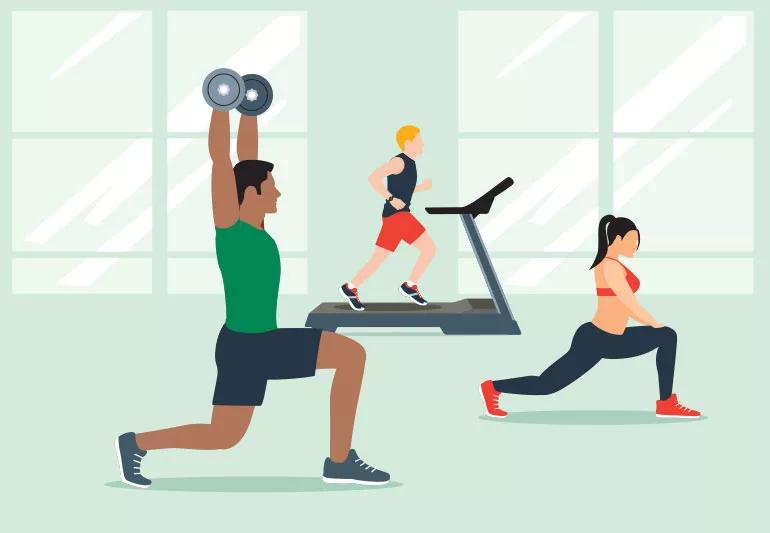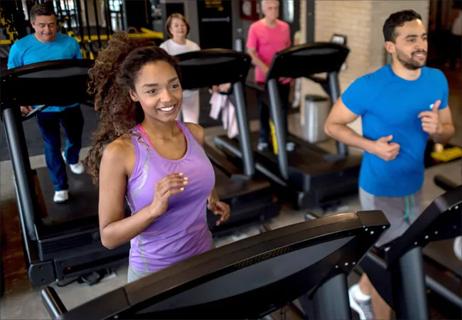Experts recommend cardio exercise five times a week and strengthening twice per week

Regular exercise is part of a healthy lifestyle. But you might be wondering how much you should work out in a given week to get the most benefits.
Advertisement
Cleveland Clinic is a non-profit academic medical center. Advertising on our site helps support our mission. We do not endorse non-Cleveland Clinic products or services. Policy
General guidelines recommend 150 minutes of moderate-intensity aerobic exercise each week, along with two strength-training sessions. But how much exercise you need each week and how intense it should be will vary based on your age and your goals.
We talked with orthopaedic surgeon Anne Marie Chicorelli, DO, about how many times a week you should be working out, and some practical advice to help you get the exercise your body needs.
Exercising throughout the week is important because it helps you build up strength, as well as strengthen specific areas of your body, including your bones and heart. “Better cardiovascular health helps lower your blood pressure and decreases inflammation,” says Dr. Chicorelli. “Strengthening your bones also helps with osteoporosis.”
Working out brings on brain-boosting benefits and boosts, too. “We can sometimes forget that the brain is a muscle, and that when we’re exercising, it’s good for our brain,” Dr. Chicorelli notes. “For example, we know that people who exercise live longer and have less risk of developing dementia.”
According to the American College of Sports Medicine (ACSM), the ideal workout regimen balances cardiovascular (heart) exercise and strength training.
Advertisement
Cardio exercise can help with weight loss, protect against Alzheimer’s disease, lift your mood and more.
Strength-training exercises build muscle, boost your metabolism and increase your endurance, among other benefits.
Making sure your weekly workout plan includes the right balance of both kinds of exercise can lead to significant health benefits, Dr. Chicorelli says.
For your heart health, ACSM guidelines recommend 150 minutes of moderate-intensity aerobic physical activity each week. In a given week, that works out to 30 minutes of moderate exercise five days per week.
Or if you’re looking to do more with less time, ramp up the dial. The ACSM says 20 minutes of high-intensity exercise three days a week will bring on the same heart-healthy benefits.
How do you gauge the intensity of your workout? Start by subtracting your age from 220. The result is your maximum heart rate.
The American Heart Association defines moderate-intensity physical activity as activity that increases your heart rate to 50% to 70% of its maximum rate. Vigorous physical activity will get your heart pumping at 70% to 85% of the maximum rate.
So, for example, a 30-year-old would have a max heart rate of 190 beats per minute (220 minus 30).
Moderate exercise for that person would mean a heart rate between 95 (190 times 0.5) and 133 (190 times 0.7) beats per minute.
Vigorous exercise for that person would mean a heart rate between 133 (190 times 0.7) and 161.5 (190 times 0.85) beats per minute.
Your max heart rate will lower as you age. A 20-year-old will have a higher target (100 to 170 beats per minute) than a 50-year-old (85 to 145 beats per minute). That means less-intense exercise can still make a big impact the older you get.
In addition to cardio work, the ACSM recommends strength-building exercises twice a week.
As you age, strength training becomes more important for bone health.
“You lose muscle mass as you get older,” Dr. Chicorelli states. “People ask me all the time, ‘Well, I walk every day. Isn’t that enough?’ and I will respond, ‘That’s great for your cardiovascular health, but it doesn’t do as much for your strength.’ Strength training, weight training and jogging are impact activities that increase your bone health and decrease your risk for fractures.”
What about focusing on specific muscle groups, like your legs, chest, abs and biceps?
“Generally, it’s better to target one muscle group at a time,” advises Dr. Chicorelli. “So, each session, you should focus on one major group.”
Advertisement
That’s not a hard-and-fast rule, though. “Be patient and do what you feel comfortable doing,” she adds. “If you’re gardening, you’re going to be working on all your muscle groups. It’s still exercise.”
Here’s the good news: Getting your recommended minutes of exercise per week doesn’t necessarily mean you need to dedicate all that time to the gym. There are plenty of ways to get your exercise in during your everyday life.
Working out is about moving your body, and many activities will get your heart rate up and help you build strength, Dr. Chicorelli notes.
“Gardening, dancing, any type of cleaning in your house, mowing the lawn, raking leaves, shoveling your snow — those are all exercise,” she continues. “Doing the laundry is also exercise because it’s lifting heavy weights.”
Strength training is also easily incorporated into your daily life.
“Resistance bands, cans of corn or soup — anything that you can grip that increases your resistance is helpful,” says Dr. Chicorelli. “That can be anything from pushing a chair while you’re doing something to lifting your child. If you’re a parent, you can incorporate your child into your activities. Doing sit-ups with your child as a weight — or any exercise where your child serves as resistance — can increase strength and be good for bonding with your child.”
Advertisement
As with movement, you can also build strength training into everyday activities you’re already doing. “If you’re washing the dishes, you can stand on one leg for 30 seconds and then switch off and stand on the other one,” she suggests. “That helps improve your balance. And we know that balance is so important as we get older.”
Making small changes to your daily activities can even count. Perhaps you’re parking a little bit farther away to go to the grocery store or taking the stairs instead of using the elevator. “Those are ways you can incorporate healthy activities into your life without it being labeled as exercise,” Dr. Chicorelli says. “But they’re still good for your overall health.”
Luckily, there isn’t much that doesn’t count as exercise. “If you think you’re exerting yourself, or if it feels like exercise — then, yes, you’re probably doing something to raise your heart rate,” she adds. “And that still is exercise.”
Sometimes, if you’re having a really busy week, you might only be able to do 10 minutes of exercise a day rather than your normal workouts of 30 minutes a day multiple times a week. That’s perfectly OK, says Dr. Chicorelli — just increase your intensity.
“Researchers have done studies that say it’s sometimes even better if you’re able to do higher-intensity workouts for short periods of time. If you were to jog three times a day for seven to 10 minutes, you get more overall health benefits from it versus walking for 30 minutes.”
Advertisement
And, above all, never discount the power of positive thinking.
“When you say ‘I’m losing weight,’ ‘losing’ is a negative word,” says Dr. Chicorelli. “That’s in contrast with positive statements like, ‘I’m trying to eat healthier’ or ‘I’m trying to improve my health.’ If you look at these things as a positive, your outlook — and what things you need to do to achieve your goals — are also positive.”
Learn more about our editorial process.
Advertisement

From less pain to a better sex life, cardio fitness does a lot for you

The short answer from an exercise physiologist

Long-term benefits of cardio fitness are most notable in older people

This technology can benefit your workouts by helping you hit your target heart rate, resulting in better overall health and wellness

Actively choose healthy habits not only when it comes to food and nutrition, but also physical activity and your mental health

Jump into the swing of things to improve your coordination, burn calories and get your heart rate going

Both practices are worth exploring and offer amazing health benefits

Turns out your health really is in your hands

Type 2 diabetes isn’t inevitable with these dietary changes

Applying a hot or cold compress can help with pain